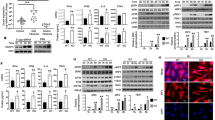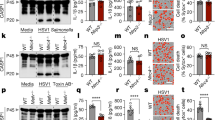Abstract
Baculovirus inhibitor of apoptosis repeat-containing 1 (Birc1) proteins have homology to several germline-encoded receptors of the innate immune system. However, their function in immune surveillance is not clear. Here we describe a Birc1e-dependent signaling pathway that restricted replication of the intracellular pathogen Legionella pneumophila in mouse macrophages. Translocation of bacterial products into host-cell cytosol was essential for Birc1e-mediated control of bacterial replication. Caspase-1 was required for Birc1e-dependent antibacterial responses ex vivo in macrophages and in a mouse model of Legionnaires' disease. The interleukin 1β converting enzyme–protease-activating factor was necessary for L. pneumophila growth restriction, but interleukin 1β was not required. These results establish Birc1e as a nucleotide-binding oligomerization–leucine-rich repeat protein involved in the detection and control of intracellular L. pneumophila.
This is a preview of subscription content, access via your institution
Access options
Subscribe to this journal
Receive 12 print issues and online access
$209.00 per year
only $17.42 per issue
Buy this article
- Purchase on Springer Link
- Instant access to full article PDF
Prices may be subject to local taxes which are calculated during checkout







Similar content being viewed by others
References
Roy, N. et al. The gene for neuronal apoptosis inhibitory protein is partially deleted in individuals with spinal muscular atrophy. Cell 80, 167–178 (1995).
Diez, E., Yaraghi, Z., MacKenzie, A. & Gros, P. The neuronal apoptosis inhibitory protein (Naip) is expressed in macrophages and is modulated after phagocytosis and during intracellular infection with Legionella pneumophila. J. Immunol. 164, 1470–1477 (2000).
Miller, L.K. An exegesis of IAPs: salvation and surprises from BIR motifs. Trends Cell Biol. 9, 323–328 (1999).
Inohara, N. & Nunez, G. NODs: intracellular proteins involved in inflammation and apoptosis. Nat. Rev. Immunol. 3, 371–382 (2003).
Viala, J., Sansonetti, P. & Philpott, D.J. Nods and 'intracellular' innate immunity. C. R. Biol. 327, 551–555 (2004).
Tschopp, J., Martinon, F. & Burns, K. NALPs: a novel protein family involved in inflammation. Nat. Rev. Mol. Cell Biol. 4, 95–104 (2003).
Ting, J.P. & Davis, B.K. Caterpiller: A novel gene family important in immunity, cell death, and diseases. Annu. Rev. Immunol. 23, 387–414 (2005).
Roy, C.R. & Tilney, L.G. The road less traveled: transport of Legionella to the endoplasmic reticulum. J. Cell Biol. 158, 415–419 (2002).
Yamamoto, Y., Klein, T.W., Newton, C.A., Widen, R. & Friedman, H. Growth of Legionella pneumophila in thioglycolate-elicited peritoneal macrophages from A/J mice. Infect. Immun. 56, 370–375 (1988).
Beckers, M.C., Yoshida, S., Morgan, K., Skamene, E. & Gros, P. Natural resistance to infection with Legionella pneumophila: chromosomal localization of the Lgn1 susceptibility gene. Mamm. Genome 6, 540–545 (1995).
Dietrich, W.F., Damron, D.M., Isberg, R.R., Lander, E.S. & Swanson, M.S. Lgn1, a gene that determines susceptibility to Legionella pneumophila, maps to mouse chromosome 13. Genomics 26, 443–450 (1995).
Diez, E. et al. Birc1e is the gene within the Lgn1 locus associated with resistance to Legionella pneumophila. Nat. Genet. 33, 55–60 (2003).
Wright, E.K. et al. Naip5 affects host susceptibility to the intracellular pathogen Legionella pneumophila. Curr. Biol. 13, 27–36 (2003).
Sanna, M.G. et al. IAP suppression of apoptosis involves distinct mechanisms: the TAK1/JNK1 signaling cascade and caspase inhibition. Mol. Cell. Biol. 22, 1754–1766 (2002).
Vogel, J.P., Andrews, H.L., Wong, S.K. & Isberg, R.R. Conjugative transfer by the virulence system of Legionella pneumophila. Science 279, 873–876 (1998).
Segal, G., Purcell, M. & Shuman, H.A. Host cell killing and bacterial conjugation require overlapping sets of genes within a 22-kb region of the Legionella pneumophila genome. Proc. Natl. Acad. Sci. USA 95, 1669–1674 (1998).
Poyet, J.L. et al. Identification of Ipaf, a human caspase-1-activating protein related to Apaf-1. J. Biol. Chem. 276, 28309–28313 (2001).
Smolewski, P. et al. Detection of caspases activation by fluorochrome-labeled inhibitors: multiparameter analysis by laser scanning cytometry. Cytometry 44, 73–82 (2001).
Kuida, K. et al. Altered cytokine export and apoptosis in mice deficient in interleukin-1β converting enzyme. Science 267, 2000–2003 (1995).
Berger, K.H. & Isberg, R.R. Two distinct defects in intracellular growth complemented by a single genetic locus in Legionella pneumophila. Mol. Microbiol. 7, 7–19 (1993).
Zuckman, D.M., Hung, J.B. & Roy, C.R. Pore-forming activity is not sufficient for Legionella pneumophila phagosome trafficking and intracellular growth. Mol. Microbiol. 32, 990–1001 (1999).
Coers, J. et al. Identification of Icm protein complexes that play distinct roles in the biogenesis of an organelle permissive for Legionella pneumophila intracellular growth. Mol. Microbiol. 38, 719–736 (2000).
Mariathasan, S. et al. Differential activation of the inflammasome by caspase-1 adaptors ASC and Ipaf. Nature 430, 213–218 (2004).
Derre, I. & Isberg, R.R. Macrophages from mice with the restrictive Lgn1 allele exhibit multifactorial resistance to Legionella pneumophila. Infect. Immun. 72, 6221–6229 (2004).
Hersh, D. et al. The Salmonella invasin SipB induces macrophage apoptosis by binding to caspase-1. Proc. Natl. Acad. Sci. USA 96, 2396–2401 (1999).
Chen, Y., Smith, M.R., Thirumalai, K. & Zychlinsky, A. A bacterial invasin induces macrophage apoptosis by binding directly to ICE. EMBO J. 15, 3853–3860 (1996).
Molmeret, M. et al. Activation of caspase-3 by the Dot/Icm virulence system is essential for arrested biogenesis of the Legionella-containing phagosome. Cell. Microbiol. 6, 33–48 (2004).
Maier, J.K. et al. The neuronal apoptosis inhibitory protein is a direct inhibitor of caspases 3 and 7. J. Neurosci. 22, 2035–2043 (2002).
Damiano, J.S., Newman, R.M. & Reed, J.C. Multiple roles of CLAN (caspase-associated recruitment domain, leucine-rich repeat, and NAIP CIIA HET-E, and TP1-containing protein) in the mammalian innate immune response. J. Immunol. 173, 6338–6345 (2004).
Edelstein, P.H., Weiss, W.J. & Edelstein, M.A. Activities of tigecycline (GAR-936) against Legionella pneumophila in vitro and in guinea pigs with L. pneumophila pneumonia. Antimicrob. Agents Chemother. 47, 533–540 (2003).
Shaner, N.C. et al. Improved monomeric red, orange and yellow fluorescent proteins derived from Discosoma sp. red fluorescent protein. Nat. Biotechnol. 22, 1567–1572 (2004).
Kagan, J.C., Stein, M.P., Pypaert, M. & Roy, C.R. Legionella subvert the functions of Rab1 and Sec22b to create a replicative organelle. J. Exp. Med. 199, 1201–1211 (2004).
Kuida, K. et al. Decreased apoptosis in the brain and premature lethality in CPP32-deficient mice. Nature 384, 368–372 (1996).
Zamboni, D.S. & Rabinovitch, M. Nitric oxide partially controls Coxiella burnetii phase II infection in mouse primary macrophages. Infect. Immun. 71, 1225–1233 (2003).
Acknowledgements
We thank K. Archer, S. Shin and J. Galán for discussions and advice. Supported by the National Institutes of Health (AI48770 and AI41699 to C.R.R., AI062017 to R.E.V., and AI049987 to W.F.D.), the Pew Latin American Fellows program (D.S.Z.), the Crohn's and Colitis Foundation of America (K.S.K.), the Eli and Edythe L. Broad Foundation (K.S.K.) and the Howard Hughes Medical Institute (R.A.F. and W.F.D.).
Author information
Authors and Affiliations
Corresponding author
Ethics declarations
Competing interests
The authors declare no competing financial interests.
Supplementary information
Supplementary Fig. 1
Caspase-1-dependency of L. pneumophila growth restriction. (PDF 29 kb)
Supplementary Fig. 2
Co-immunoprecipitation of Ipaf and Birc1e. (PDF 26 kb)
Rights and permissions
About this article
Cite this article
Zamboni, D., Kobayashi, K., Kohlsdorf, T. et al. The Birc1e cytosolic pattern-recognition receptor contributes to the detection and control of Legionella pneumophila infection. Nat Immunol 7, 318–325 (2006). https://doi.org/10.1038/ni1305
Received:
Accepted:
Published:
Issue Date:
DOI: https://doi.org/10.1038/ni1305
This article is cited by
-
Lysosomal cathepsins act in concert with Gasdermin-D during NAIP/NLRC4-dependent IL-1β secretion
Cell Death & Disease (2022)
-
Sensing soluble uric acid by Naip1-Nlrp3 platform
Cell Death & Disease (2021)
-
Comprehensive review of ASC structure and function in immune homeostasis and disease
Molecular Biology Reports (2020)
-
TOLLIP deficiency is associated with increased resistance to Legionella pneumophila pneumonia
Mucosal Immunology (2019)
-
Neutrophil pyroptosis: new perspectives on sepsis
Cellular and Molecular Life Sciences (2019)



